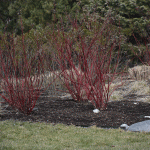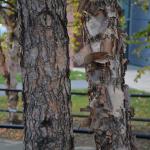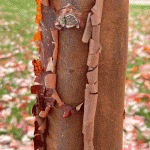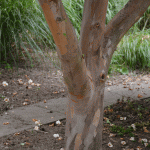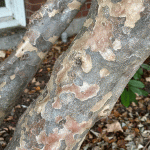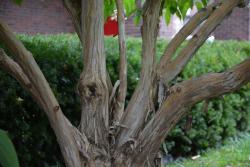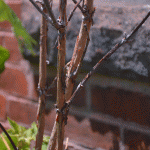A monthly e-newsletter from UMass Extension for landscapers, arborists, and other Green Industry professionals, including monthly tips for home gardeners.
To read individual sections of the message, click on the section headings below to expand the content.
To print this issue, either press CTRL/CMD + P or right click on the page and choose Print from the pop-up menu.
2024 UMass Garden Calendar
Looking for a great holiday gift idea for the enthusiastic gardener on your holiday gift list? Or want to show your clients that you appreciate their business this year!
UMass Extension works with the citizens of Massachusetts to help you make sound choices about growing, planting, and maintaining plants in our landscapes, including vegetables, backyard fruits, and ornamental plants. Our 2024 calendar continues UMass Extension’s tradition of providing gardeners with useful and practical information. Many people also love the daily tips and find the daily sunrise/sunset times highly useful!
Purchasing plants for the landscape can be a considerable investment of both time and money. Selecting the right plant for the right place is the first step in making the most of this investment. This means selecting the best-suited plant material for your location according to light exposure, water availability, hardiness zone, soil conditions, and environmental exposure. The next step, and just as important to success, is following proper planting procedure.
Our 2024 calendar includes guidelines for preparing the planting hole, avoiding problems with circling roots, amending the soil before planting, and shares the results of a two-year UMass study looking at plant establishment success using different root preparation methods at planting.
COST: $14.50/ea plus shipping, special pricing is available on orders of 10 copies or more.
FOR IMAGES IN THE CALENDAR, details, and ordering info, go to http://ag.umass.edu/gardencalendar
As always, each month features:
- An inspiring garden image.
- Daily gardening tips for Northeast growing conditions.
- Daily sunrise and sunset times.
- Phases of the moon.
- Plenty of room for notes.
- Low gloss paper for easy writing.
Fabulous Fall (and Winter) Fruit
In the fall, foliage seems to get all the attention. However, the lower temperatures of late October and November encourage leaf drop and the end to colorful fall foliage. For some plants, the fall of leaves is like clearing the stage for the next act – the fabulous fall (and winter) fruit. If not eaten by birds, berries and drupes often remain on plants and, in some cases, persist well into winter. For many species, the fruit has been present since early fall (or even late summer), but has been hidden among the foliage or competing with the foliage for attention.
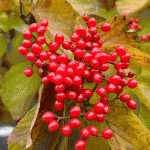 Having already been on stage for most of the growing season, for Viburnum species the fall drupe display is the final act. Viburnum dentatum, V. nudum, and V. opulus var. americanum are all excellent options for fall fruit display. All three species are eastern US natives with cultivars offering superior ornamental features. Unfortunately, all three are highly susceptible to Viburnum leaf beetle, so other species should be considered if viburnum leaf beetle is present in the area. Viburnum, although monoecious (has both male and female plant parts), are not generally self-fertile and need cross-pollination from another viburnum for optimum fruit set. Viburnum dentatum (arrowwood viburnum) has blue-black, berry-like drupes in clusters. Cultivars include more compact options such as ‘Christom’ (Blue Muffin) and ‘KLMseventeen’ (Little Joe) along with the more upright ‘Ralph Senior’ (Autumn Jazz) and ‘Synnestvedt’ (Chicago Lustre), known for its abundant fruit. The berries of V. nudum (smooth witherod) change color as they ripen from light to dark pink to blue and finally purplish black. The cultivar ‘Bulk’ (Brandywine) is a compact form with berry clusters that have both pink and blue berries in the same cluster. Viburnum opulus var. americanum (American cranberry bush) has bright red, cranberry like berries. If a Viburnum with good berry set and better resistance to viburnum leaf beetle is needed, Viburnum dilatatum is a non-native species that is only moderately susceptible to viburnum leaf beetle. The cultivar ‘Henneke’ (cardinal Candy) is covered in pendulous clusters of bright right berries from early fall into late winter.
Having already been on stage for most of the growing season, for Viburnum species the fall drupe display is the final act. Viburnum dentatum, V. nudum, and V. opulus var. americanum are all excellent options for fall fruit display. All three species are eastern US natives with cultivars offering superior ornamental features. Unfortunately, all three are highly susceptible to Viburnum leaf beetle, so other species should be considered if viburnum leaf beetle is present in the area. Viburnum, although monoecious (has both male and female plant parts), are not generally self-fertile and need cross-pollination from another viburnum for optimum fruit set. Viburnum dentatum (arrowwood viburnum) has blue-black, berry-like drupes in clusters. Cultivars include more compact options such as ‘Christom’ (Blue Muffin) and ‘KLMseventeen’ (Little Joe) along with the more upright ‘Ralph Senior’ (Autumn Jazz) and ‘Synnestvedt’ (Chicago Lustre), known for its abundant fruit. The berries of V. nudum (smooth witherod) change color as they ripen from light to dark pink to blue and finally purplish black. The cultivar ‘Bulk’ (Brandywine) is a compact form with berry clusters that have both pink and blue berries in the same cluster. Viburnum opulus var. americanum (American cranberry bush) has bright red, cranberry like berries. If a Viburnum with good berry set and better resistance to viburnum leaf beetle is needed, Viburnum dilatatum is a non-native species that is only moderately susceptible to viburnum leaf beetle. The cultivar ‘Henneke’ (cardinal Candy) is covered in pendulous clusters of bright right berries from early fall into late winter.
 Aronia melanocarpa (black chokeberry) and A. arbutifolia (red chockeberry) are also native species with multiple seasons of interest. Aronia melanocarpa has black berries with two interesting, low growing cultivars good for the landscape; ‘UCONNAM012’ (Ground Hog) grows up to 1’ high, spreading to 3’ wide, and ‘UCONSSAM165’ (Low Scape Mound) which grows 1-2’ high by 3-4’ wide. Both cultivars have the same ornamental features as the species, including the black berries. Aronia arbutifolia has red berries, with its cultivar ‘Brilliantissma’ being more compact with better red fall color and larger glossier red berries.
Aronia melanocarpa (black chokeberry) and A. arbutifolia (red chockeberry) are also native species with multiple seasons of interest. Aronia melanocarpa has black berries with two interesting, low growing cultivars good for the landscape; ‘UCONNAM012’ (Ground Hog) grows up to 1’ high, spreading to 3’ wide, and ‘UCONSSAM165’ (Low Scape Mound) which grows 1-2’ high by 3-4’ wide. Both cultivars have the same ornamental features as the species, including the black berries. Aronia arbutifolia has red berries, with its cultivar ‘Brilliantissma’ being more compact with better red fall color and larger glossier red berries.
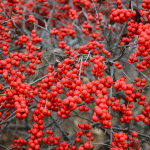 Ilex verticillata (winterberry) is another amazing native addition to the landscape. The bright red berries grace the plants in fall, standing out on the bare branches of late autumn and winter. Cultivars offer larger berries, along with orange and yellow options. Ilex are dioecious species, meaning that there are separate male and female plants and both are needed for pollination and good berry set. One male is needed for every 6 to 10 female plants. ‘Afterglow’ is a female cultivar with orange-red berries. ‘Cacapon’ is a female cultivar with bright red berries. ‘Goldfinch’ is a compact gold fruited female cultivar. ‘Nana’ (Red Sprite) is a dwarf female cultivar. The suggested pollinator for both ‘Goldfinch’ and ‘Nana’ is ‘Jim Dandy’. ‘Southern Gentleman’ is the suggested male pollinator for ‘Cacapon’, ‘Sparkleberry’, ‘Sunset’, ‘Winter Red’, and ‘Winter Gold’. ‘Spriber’ (Berry Nice ) is a female cultivar known for a dark red, dense heavy fruit set with good retention. ‘Winter Gold’ is a female cultivar with orange-yellow berries, and ‘Winter Red’ is a heavy fruiting female cultivar.
Ilex verticillata (winterberry) is another amazing native addition to the landscape. The bright red berries grace the plants in fall, standing out on the bare branches of late autumn and winter. Cultivars offer larger berries, along with orange and yellow options. Ilex are dioecious species, meaning that there are separate male and female plants and both are needed for pollination and good berry set. One male is needed for every 6 to 10 female plants. ‘Afterglow’ is a female cultivar with orange-red berries. ‘Cacapon’ is a female cultivar with bright red berries. ‘Goldfinch’ is a compact gold fruited female cultivar. ‘Nana’ (Red Sprite) is a dwarf female cultivar. The suggested pollinator for both ‘Goldfinch’ and ‘Nana’ is ‘Jim Dandy’. ‘Southern Gentleman’ is the suggested male pollinator for ‘Cacapon’, ‘Sparkleberry’, ‘Sunset’, ‘Winter Red’, and ‘Winter Gold’. ‘Spriber’ (Berry Nice ) is a female cultivar known for a dark red, dense heavy fruit set with good retention. ‘Winter Gold’ is a female cultivar with orange-yellow berries, and ‘Winter Red’ is a heavy fruiting female cultivar.
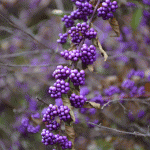 Callicarpa species (beautyberry) offer purple berries, covering arching branches as they drape to the ground. Berries are showy when the yellow fall foliage is still on the plant, but even more evident as berries remain after leaf drop. Unfortunately, the berries don’t linger long into winter, but the unique color makes Callicarpa a worthwhile landscape addition. Callicarpa dichotoma ‘Early Amethyst’ offers large clusters of glossy amethyst-purple berries, while C. japonica ‘Heavy Berry’ has a large crop of violet berries lasting October through early December.
Callicarpa species (beautyberry) offer purple berries, covering arching branches as they drape to the ground. Berries are showy when the yellow fall foliage is still on the plant, but even more evident as berries remain after leaf drop. Unfortunately, the berries don’t linger long into winter, but the unique color makes Callicarpa a worthwhile landscape addition. Callicarpa dichotoma ‘Early Amethyst’ offers large clusters of glossy amethyst-purple berries, while C. japonica ‘Heavy Berry’ has a large crop of violet berries lasting October through early December.
Another unique option is snowberry. Symphoricarpos species have clusters of drupes that cover bare stems through most of the winter. Berry color differs by species and cultivar. Symphoricarpos x chenaultii has white berries that blush pink on the side of the berry exposed to direct sun. ‘Hancock’ is a dwarf cultivar with coral pink berries. Symphoricarpos x doorenbosii ‘Kordes’ (Amethyst) has abundant, vivid deep purple-pink berries that ripen in September and persist into winter. Symphoricarpos x ‘Bokrabright’ (Bright Fantasy) is covered in large white drupes well into winter. Symphoricarpos ‘Sofie’ (Proud Berry) has bright pink berries early in fall.
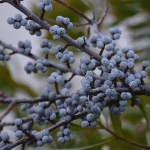 A stark contrast to the colorful berries of many species are the subtle tiny, gray-white fruits of Myrica pensylvanica (bayberry). The fruit is covered with a fragrant substance used to make bayberry candles and soaps. ‘Morton’ is a female clone that is more dwarf in size.
A stark contrast to the colorful berries of many species are the subtle tiny, gray-white fruits of Myrica pensylvanica (bayberry). The fruit is covered with a fragrant substance used to make bayberry candles and soaps. ‘Morton’ is a female clone that is more dwarf in size.
Gaultheria procumbens is a native, evergreen groundcover that has bright red edible berries in fall into winter. Other ornamental attributes include bell-shaped white flowers in summer and winter foliage with shade of purple.
 Evergreen options include Ilex species such as Ilex x meserveae ‘Blue Princess’ (‘Blue Prince’ is the male) and Ilex ‘Mesog’ (China Girl). Juniper virginiana is a native juniper species with female plants producing grayish-blue berry-like cones that add winter interest.
Evergreen options include Ilex species such as Ilex x meserveae ‘Blue Princess’ (‘Blue Prince’ is the male) and Ilex ‘Mesog’ (China Girl). Juniper virginiana is a native juniper species with female plants producing grayish-blue berry-like cones that add winter interest.
Whatever the species, berries and drupes are a wonderful addition to the fall and winter landscape. They can provide a pop of color in a dreary, dormant landscape. They can also provide an ecosystem service, as berries and drupes are often popular with birds.
Mandy Bayer, PhD, Horticulturist and Landscape Plant Specialist
Trouble Maker of the Month
Brown Spot Needle Blight
Brown spot needle blight (BSNB) is caused by the fungal pathogen Lecanosticta acicola (formerly Mycosphaerella dearnessii). The primary host of this native pathogen in southern New England is eastern white pine (Pinus strobus), but numerous five-, three- and two-needle pines are also infected. Based on samples submitted to the UMass Plant Diagnostic Laboratory, additional hosts in southern New England include (but are not limited to): Japanese red pine (P. densiflora), limber pine (P. flexilis), mugo pine (P. mugo), Austrian pine (P. nigra), Scots pine (P. sylvestris), and Japanese black pine (P. thunbergii). Lecanosticta acicola is distributed widely throughout the northern hemisphere, attacking pines in North America, Europe and Asia. For a broader list of known hosts, see Sinclair and Lyon (p. 26; 2005).
White pine needle damage (WPND) was first documented in 2009 and is a chronic stress for eastern white pines throughout eastern North America (Broders et al. 2015). Symptoms of infection by Lecanosticta on eastern white pine often first appear as yellowing to browning of older needles in late spring and early summer. Once these symptoms develop, diseased needles are quickly shed from the canopy. Symptoms can also appear as brown, blighted needle tips. In these cases, needles may be retained in the canopy for longer periods of time as the base remains green. Studies and surveys have concluded that L. acicola is one of two fungi (along with Septorioides strobi) primarily responsible for WPND in the northeast (Broders et al. 2015, Wyka et al. 2018).
BSNB can first develop in the lower or interior canopy where shade and moisture are abundant. Historically, lower canopy branches and small trees were most susceptible (Sinclair and Lyon 2005), but since the WPND outbreak started in 2009, mature trees are diseased throughout the entire canopy. Research has shown this increase in disease incidence and severity is due to a change in regional climate that has created ideal conditions for disease development (Wyka et al. 2017). Specifically, mild temperatures, high overnight humidity, and a higher frequency of rain events from May through July are stimulating disease development. The spores of L. acicola can germinate and infect pine needles only when they are wet, and the pathogen largely goes dormant during extended dry periods. Therefore, the higher frequency of rain events during the spring and early summer, when newly developing pine needles are most susceptible to infection, is a driving force in the WPND epidemic.
Spores of L. acicola are dispersed by rain and wind from older, diseased needles to the developing, current season's needles in late spring and early summer (Sinclair and Lyon 2005). Peak fungal spore dispersal coincides with peak needle shedding, which takes place between mid-May to mid-June in southern New England. On eastern white pine, once the current season’s needles are infected, they often remain free of symptoms for many months. Symptoms of the disease can be first detected in autumn to winter as tan-brown or reddish-brown foliar lesions, primarily at the needle tips. However, necrotic spots can also appear in the middle and lower sections of the needles. Needle tips often die back to the spot of the lesions until they completely die later on. Symptoms may develop more quickly on two- and three-needle pines, especially if trees are stressed. In the late spring and early summer – nearly one year after infection – needles become yellow to straw-colored and are prematurely shed from the canopy (Sinclair and Lyon 2005). Older needles are shed in large numbers when new growth is still developing, giving trees are very thin and weak appearance. Once the new growth is fully developed, the trees appear fuller and more robust once more. Needle blight diseases do not kill white pines alone but lead to reduced growth and reserves to combat against secondary pests and pathogens and increased sensitivity to drought and winter injury. When severe, trees can suffer serious needle loss as a result of BSNB.
Management
BSNB can be very difficult to control on infected pines. Prior to 2009, disease severity was linked to particularly wet spring and early summer periods. The disease was usually located on sheared Christmas trees or young white pines in dense groves. However, since 2009, high levels of inoculum have persisted across forest and developed landscapes. In general, disease incidence is more uniform in northern New England (Vermont, New Hampshire and Maine) while incidence can be patchy in southern New England (Massachusetts, Connecticut and Rhode Island). Meaning, badly infected trees in Massachusetts may be close to trees that appear healthy.
Pruning of lower canopy and heavily diseased branches can help to improve air flow, light penetration, reduce moisture lingering in the canopy and reduce fungal inoculum. Thinning of dense groves of eastern white pine can reduce disease severity; thinning operations have been shown to improve the health of white pines chronically diseased by needle blight (McIntire et al. 2018). Provide full sun settings for ornamental pines that are susceptible to infection by L. acicola. Drought stress predisposes many conifers to needle blight diseases, therefore supplemental water is necessary for newly planted and young trees. Fungicides labeled for use that can may have utility against L. acicola include: azoxystrobin, benzovindiflupyr, copper salts of fatty and/or rosin acids, copper hydroxide, mancozeb, metconazole, phosphites, propiconazole and thiophanate-methyl. Fungicide application during the spring and early summer season can allow new needles to emerge and remain uninfected, restoring vigor to the tree. However, for large and mature trees, fungicide application is often not possible. In these cases, soil drenching with phosphites for root uptake may provide some level of control. Nitrogen fertilization can also help trees regain nutrients lost due to premature needle shedding.
Photos of BSNB symptoms and signs can be found at https://ag.umass.edu/landscape/fact-sheets/brown-spot-needle-blight.
Citations:
Broders K., Munck I., Wyka S, Iriarte G., and Beaudoin E. 2015. Characterization of fungal pathogens associated with white pine needle damage (WPND) in Northeastern North America. Forests 6: 4088–4104.
McIntire C.D., Munck I.A., Ducey M.J., and Asbjornsen H. 2018. Thinning treatments reduce severity of foliar pathogens in eastern white pine. Forest Ecology and Management 423: 106–113.
Sinclair W.A., and Lyon H.H. 2005. Diseases of Trees and Shrubs. Cornell University Press, Ithaca, NY.
Wyka S.A., Smith C., Munck I.A., Rock B.N., Ziniti B.L., and Broders K. 2017. Emergence of white pine needle damage in the northeastern United States is associated with changes in pathogen pressure in response to climate change. Global Change Biology 23: 394–405.
Wyka S.A. Munck I.A. Brazee N.J., and Broders K.D. 2018. Response of eastern white pine and associated foliar, canker and root rot pathogens to climate change. Forest Ecology and Management 423: 18–26.
Nicholas J. Brazee, UMass Extension Plant Pathologist
Q&A
Q: How long do you need to wait after a glyphosate application before you can plant or seed?
A: You can plant or seed immediately into the treated area.
To better understand why this is the case we will briefly discuss soil adsorption coefficient (Kd/Koc). Soil adsorption coefficients are very important input parameters for estimating environmental distribution and the environmental exposure level of a chemical substance, such as an herbicide. Soil adsorption coefficient (Kd/Koc) measures the mobility of a substance in soil. A very high value means the substance is strongly adsorbed onto soil colloids and organic matter, so therefore the substance does not move throughout the soil. A very low value means that a substance is highly mobile in soil.
Glyphosate’s behavior in soil is best described in the Herbicide Handbook (2014) published by the Weed Science Society of America. In this publication, glyphosate adsorption characteristics are described as: “...rapidly and tightly adsorbed to soil. Organic matter, clay, silt or sand content, and soil pH have minimal effect on adsorption. Glyphosate sorption correlates with the amount of vacant phosphate sorption sites and may occur through binding of the phosphoric acid moiety. High levels of metallic cations in clay soils increase the amount of glyphosate adsorbed. Strong adsorption to soils is evidenced in part by low phytotoxicity with soil applications. Crops can be seeded or transplanted immediately into treated areas.”
The strong adsorption to soil colloids and organic matter render glyphosate instantly herbicidally inactive. An example of this phenomenon can be seen if glyphosate products are applied to weeds that are along a dirt driveway or road. The dust on the weed leaves bind with and deactivate glyphosate, resulting in poor to little efficacy. Therefore, avoid mixing glyphosate with spray tank water that might have a small amount of suspended soil particles or organic material such as pond or stream water. In this case, the glyphosate will bind to the small particles in the spray tank water and become herbicidally inactive. Avoiding these types of situations is an example of good pesticide best management and stewardship practices.
Yes, there is a simple answer; “You can plant or seed immediately into the treated area.” As an Extension weed specialist, I feel that some explanation about why that is the correct answer is helpful. Understanding why that is the answer to a particular question often builds a stronger fundamental knowledge base about herbicides. One last comment: herbicides with a high or very high soil adsorption coefficient (Kd/Koc) have a very low potential for soil leaching. A typical glyphosate application remains at the soil surface, has a very low potential for leaching, and is degraded by soil microbes, with a typical half-life of less than 25 days.
Q: I hear mention of herbicide resistance occurring in some weed species. I understand from what I have read that this is a serious problem facing agriculture. Do we have weeds in New England that are resistant to herbicides?
A: You are correct in your understanding that the development of herbicide resistant weeds is a serious problem within US agricultural production. Recently, there has been increased interest in this topic along with occasional confusion about the difference between herbicide tolerance and herbicide resistance. There is a recent article in Hort Notes Volume 34:3 that provides detailed information on the subject.
Randy Prostak, UMass Extension Weed Specialist
Garden Clippings Tips of the Month
November is the month to . . . .
- Plant garlic. It is best to buy garlic bulbs for planting from a garden center or reputable grower online as opposed to a grocery store. Garlic sold at grocery stores is usually a soft-necked variety grown in warmer climates and often treated to inhibit sprouting. In our region, hard-necked varieties such as ‘Music’, ‘Spanish Roja’, and ‘German Red’ perform well. Work plenty of organic matter into the soil prior to planting. After planting, wait until the ground freezes before covering the bed with a thick (3-inch) layer of straw mulch.
- Sort through leftover seed packets. Most seeds that were purchased fresh this year can be saved for at least another year, if stored properly (cool, dry, and dark). Seeds that should be kept no more than one year include sweet corn, onions, leeks, okra, parsley, and parsnips.
- Keep planting spring flowering bulbs. Look for late season bargains on bulbs at garden centers or online. Bulbs can be planted right up until the ground begins to freeze. A layer of mulch applied over bulbs can delay freezing of the ground, allowing some extra time for root development.
- Experiment with fall sowing in the flower garden. Take advantage of natural freeze-thaw cycles over the winter months to improve spring germination of certain annuals, biennials, and perennials. Good candidates include bachelor’s button, columbine, foxglove, poppy, and pansy. Scatter seeds over bare ground after a killing frost (to prevent premature germination) but before the ground freezes.
- Put tree guards in place. Prevent vole and rabbit gnawing of bark and roots of fruit trees and other thin-barked trees by placing tree guards around the stem of each tree. A tree guard need not be fancy; it can be a simple cylinder constructed from ½-inch or ¼-inch wire mesh. Set the guard several inches deep into the soil and have it extend upwards by several feet. Mow grass around trees to remove vole hiding places.
- Examine deciduous trees for structural defects. Once leaves are off the trees, it becomes easier to see common defects such as broken, diseased, or dead limbs, rubbing branches, excessively dense branching, narrow or V-shaped crotches, and competing terminal shoots. It is straightforward to correctively prune smaller, recently planted trees; hire a licensed arborist when dealing with large trees.
- Stay off the lawn when it is covered with frost. Walking on frosted grass can damage the crowns of grass plants, resulting in bare spots in the lawn next spring.
- Finish mowing the lawn. Consider lowering the cutting height a bit for the last mowing of the season, although be wary of cutting too low, which may result in injury to crowns of grass plants. Conversely, leaving grass too long will cause grass blades to flop over and compress, which creates ideal conditions for development of snow mold and other turf diseases.
- Group houseplants together. Grouping plants helps reduce water loss from plants due to warm, dry indoor conditions. Before grouping plants, examine them for spider mites, scales, mealybugs, aphids, and whiteflies. Keep any infested plants apart from others and wash away pests with water or, if necessary, treat pests with insecticidal soap or neem oil according to label instructions.
- Clean and condition garden tools. Use a stiff brush to remove caked-on soil from metal surfaces of garden tools before washing them with soap and water. Let tools dry, then spray or wipe metal with mineral oil or beeswax. Wipe wooden handles with linseed oil, mineral oil, or other wood protectant.
- Drain garden hoses and store indoors for the winter. Also bring in bird baths, containers, and any garden ornaments susceptible to breakage by freezing temperatures.
Jennifer Kujawski, Horticulturist
Beautiful Bark for Winter Appeal
It's now the quiet season. Shorter days and cooler temperatures have heralded an end to the growing season. For most plants, it's time to lay dormant until the longer days and warm temperatures of spring arrive. Winter can be a challenging time to bring excitement to the landscape, but there are still opportunities. Bark, often hidden behind leaves in the growing season, presents itself. Vibrant stem colors and exfoliating bark once obscured by the foliage become the stars of the show. Structure and form also become apparent.
With the green screen of leaves gone, the colorful stems of Tatarian, red-twig, bloodtwig, and red osier dogwoods come into display in late autumn. Multiple Cornus sp. offer red stems including C. alba, C. sanguinea, and C. sericea (aka C. stolonifera) and cultivars can offer yellow or orange stems. All species are similar in that they are large growing shrubs with clusters of white flowers in late spring/early summer. C. sericea is native to North America and grows 6-9’ tall and 7-10’ wide. White flowers are followed by white drupes in summer. Cultivars include dwarf options, yellow stems, variegated foliage, or yellow foliage. 'Farrow’ (Arctic Fire) is a dwarf cultivar with bright red stems. ‘Flaviramea’ is a yellow stemmed cultivar that is somewhat compact. ‘Isanti’ is a rapid-growing, moderate sized cultivar with red stems. ‘Sunshine’ has yellow foliage and red stems. ‘KLM RR’ (Erica the Blonde) also has golden foliage and red stems.
C. alba is native to Asia and is slightly larger growing, reaching 8-10’ tall and wide. Similar to C. sericea, it has white flowers in late spring/early summer that are followed by white berries. It does not spread as much as C. sericea. Cultivars include ‘Bailhalo’ (Ivory Halo) that has variegated leaves and red stems. ‘Siberian Pearls’ is known to have more abundant fruit than the species or other cultivars along with bright red stems in winter. ‘Byboughen’ (Neon Burst) is a compact cultivar with bright yellow to chartreuse foliage during the growing season and bright red stems in the winter. C. sanguinea is native to Europe and Asia; it is also larger growing, reaching 8-15’ tall and wide. White flowers give way to blue-black drupes in early fall, but the fruit display is not overly showy. Mature stems are more green-gray and younger stems are more red. Cultivars can be more reliable in stem color, smaller, and less spreading than the species. ‘Midwinter Fire’ has yellow winter stems tipped in red. ‘Winter Beauty’ has orange-yellow winter stems tipped with red. ‘Cato’ (Artic Sun) has bright yellow stems tipped with red and a dwarf habit. For all dogwoods in this group, it is advised to remove approximately ¼ of the oldest stems every year to stimulate new growth, which has the best coloration. An alternative is hard pruning (to around 8” high) every 2-3 years to renew growth.
Kerria japonica is another shrub offering stems with winter color. Kerria is a spring bloomer, covered in bright yellow flowers. The thin, arching branches turn bright green for the winter. Itea virginica can have reddish-purple stems on the side exposed to the sun, although not nearly as prominent as the Cornus species.
Some cultivars of Acer palmatum also offer colorful branches. There are a plethora of Acer palmatum cultivars on the market offering a variety of sizes, forms, leaf colors, and leaf shapes. ‘Sango Kaku’ is an upright cultivar with orange-red winter branches. Coloration fades with age so trunks tend to fade to a more gray-pink color. ‘Bihou’ is another upright form with orange winter stems. Salix alba subsp. vietellina ‘Britzensis’ is a large multi-stemmed shrub that has new growth stems that turn orange-red in winter. To maintain the vibrant branch color, plants should be pruned severely (to around 1’) in late winter, before new growth appears.
The white bark of many birch species can be striking in the landscape. Betula utilis var. jacquemontii has some of the whitest bark found on any birch species. Betula papyrifera is another white barked birch that prefers cooler climates.
Exfoliating bark, although used by gardeners for visual appeal, is a survival mechanism that plants have developed to help rid themselves of pests such as bacteria and fungi. Bark can be peeling, curling, or platy. A popular ornamental tree with exfoliating bark is river birch. Betula nigra is an eastern US native. It has brown to salmon-brown outer bark that peels away to reveal lighter inner bark. ‘Cully’ (Heritage) has salmon-cream to brown bark exfoliating to reveal a cream-colored interior. ‘Little King’ (Fox Valley) is a dwarf cultivar with orange-brown bark exfoliating to lighter brown inner bark at a young age. Acer griseum, or paperbark maple, is an outstanding small landscape tree with exfoliating bark. It is slow growing to 20-30’ tall and 15-25’ wide. Bark is copper orange to cinnamon red to brown, exfoliating even on younger branches.
Whereas the bark of Betula nigra and Acer griseum is more curling and peeling, the bark of other species has more of a look of colorful patchwork. Stewartia pseudocamellia bark is a mix of gray, orange, and brown with larger branches and the trunk having more exfoliation. The species name, pseudocamellia, means false camellia, a nod to the camellia-like flowers present in early summer. Similar to Stewartia, Cornus kousa, also has patchy exfoliating bark in a mix of gray, tan and deep brown. Bark is one of the easiest ways to tell C. kousa and C. florida apart, as C. florida has interesting “alligator skin” blocky bark. Both species offer the classic dogwood flowers and good fall color.
 Ulmus parvifolia, commonly known as lacebark elm, has mottled bark. On mature trees, the bark flakes off, revealing patches of gray, orange, cream, brown and green. Pinus bungeana, lacebark pine, has patchy exfoliating bark with the outer bark shedding to reveal inner bark in a mix of white, olive, silver, and brown. Note that it takes 10 years of more for the tree to mature to the point of exfoliating. Older plants of Acer buergerianum have platy, exfoliating bark in a mix of gray, orange and brown. Parrotia persica has gray, green, and brown patchy exfoliating bark.
Ulmus parvifolia, commonly known as lacebark elm, has mottled bark. On mature trees, the bark flakes off, revealing patches of gray, orange, cream, brown and green. Pinus bungeana, lacebark pine, has patchy exfoliating bark with the outer bark shedding to reveal inner bark in a mix of white, olive, silver, and brown. Note that it takes 10 years of more for the tree to mature to the point of exfoliating. Older plants of Acer buergerianum have platy, exfoliating bark in a mix of gray, orange and brown. Parrotia persica has gray, green, and brown patchy exfoliating bark.
Other species have bark that peels into strips. Heptacodium miconoides bark exfoliates the brown outer bark to show a lighter brown, creamy underbark. Metasequoia glyptostroboides has bark that exfoliates into narrow strips, being reddish brown when young and maturing to deeper brown. Although not as prominent as trees, some shrubs also offer exfoliating bark. Physocarpus opulifolius has exfoliating brown bark that is more prominent with age. Selective pruning helps to reveal the bark. Hydrangea quercifolia bark exfoliates in papery strips, revealing light brown to cinnamon brown inner bark.
A final category of attractive bark is bark with sheen. Prunus species can have vibrant, glossy cinnamon brown to red-brown to orange-brown bark with lenticles. The attractiveness of bark is variable with the species. Options include Prunus maackii, which does best in colder climates (zones 2-6), Prunus ‘Okame’, which has reddish brown bark with lenticles, and Prunus serrula, which has shiny, reddish brown, exfoliating bark. Prunus serrula can be challenging in cultivation.
Whether exfoliating, colorful, or shiny, bark can provide some much-needed excitement to the winter landscape. Most of these plants also offer additional ornamental attributes during the growing season.
Mandy Bayer, PhD, Horticulturist and Landscape Plant Specialist
Upcoming Events
For details and registration options for these upcoming events, go to the UMass Extension Landscape, Nursery, and Urban Forestry Program Upcoming Events Page.
-
Nov 29 - In-Person Fall Wrap-Up for Landscape and Lawn Care, Milford MA, 8:30 am to 3:30 pm, Milford MA. Details at https://ag.umass.edu/landscape/upcoming-events; pre-registration is required. Credits available: Morning ONLY (TURF): 3 pesticide contact hours for categories 37 or Applicators License. Association credits: 1 MCH and 1 MCLP; afternoon ONLY (WOODY ORNAMENTALS): 3 pesticide contact hours for categories 29, 36, or Applicators License. Association credits: 2.75 ISA, 1 MCA, 1 MCLP, and 1 MCH; if ATTENDING THE ENTIRE DAY: 6 for Applicators License; 3 pesticide contact hours for categories 29 and 36, or 3 pesticide contact hours for category 37. Association credits: 2.75 ISA, 1 MCA, 2 MCLP, and 2 MCH.
-
Pesticide Exam Preparation and Recertification Courses: These workshops are held virtually. Contact Natalia Clifton at nclifton@umass.edu or go to https://www.umass.edu/pested for more info.
Additional Resources
For detailed reports on growing conditions and pest activity – Check out the Landscape Message
For professional turf managers - Check out our Turf Management Updates
For commercial growers of greenhouse crops and flowers - Check out the New England Greenhouse Update website
For home gardeners and garden retailers - Check out our home lawn and garden resources
TickTalk webinars - To view recordings of past webinars in this series, go to: https://ag.umass.edu/landscape/education-events/ticktalk-with-tickreport-webinars
Diagnostic Services
Landscape and Turf Problem Diagnostics - The UMass Plant Diagnostic Lab is accepting plant disease, insect pest and invasive plant/weed samples. By mail is preferred, but clients who would like to hand-deliver samples may do so by leaving them in the bin marked "Diagnostic Lab Samples" near the back door of French Hall. The lab serves commercial landscape contractors, turf managers, arborists, nurseries and other green industry professionals. It provides woody plant and turf disease analysis, woody plant and turf insect identification, turfgrass identification, weed identification, and offers a report of pest management strategies that are research based, economically sound and environmentally appropriate for the situation. Accurate diagnosis for a turf or landscape problem can often eliminate or reduce the need for pesticide use. See our website for instructions on sample submission and for a sample submission form at http://ag.umass.edu/diagnostics.
Soil and Plant Nutrient Testing - The lab is accepting orders for Routine Soil Analysis (including optional Organic Matter, Soluble Salts, and Nitrate testing), Particle Size Analysis, Pre-Sidedress Nitrate (PSNT), Total Sorbed Metals, and Soilless Media (no other types of soil analyses available at this time). Testing services are available to all. The lab provides test results and recommendations that lead to the wise and economical use of soils and soil amendments. For updates and order forms, visit the UMass Soil and Plant Nutrient Testing Laboratory web site.
Tick Testing - The UMass Center for Agriculture, Food, and the Environment provides a list of potential tick identification and testing options at: https://ag.umass.edu/resources/tick-testing-resources.

